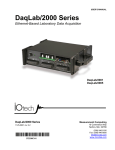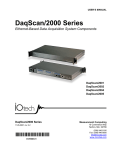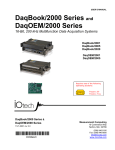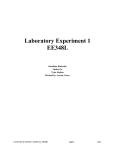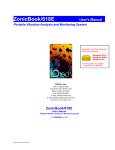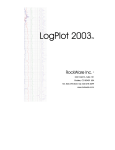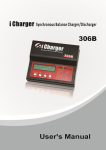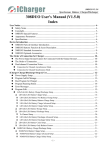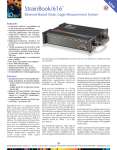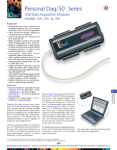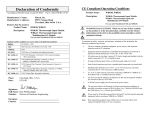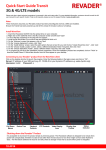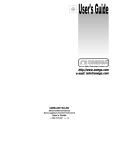Download PostView - Measurement Computing
Transcript
PostView User's Guide.. Post Data Acquisition Analysis Application PostView Post Data Acquisition Analysis Application p/n PostView User’s Guide 457-0916 Rev. 1.0 907293 1 Measurement Computing 10 Commerce Way Norton, MA 02766 (508) 946-5100 Fax: (508) 946-9500 [email protected] www.mccdaq.com 2 908893 PostView User’s Guide PostView Overview …… 1 System Requirements …… 4 Installation ……4 Layout and Controls …… 5 Understanding the Status Bar …… 8 Changing Display Parameters …… 9 Overview PostView is a time-domain post-acquisition data viewing application that can be integrated with primary data acquisition software, including DaqView, Personal DaqView, ChartView, LogView, and WaveView. The viewer provides a means of setting up several display pages, each with one or more scopes and single or multiple channels to view as Analog, Counts, or Logic traces (with one type per scope). You can set up PostView to run from your data acquisition program’s ViewData button. Configuration instructions follow shortly. Note that you cannot mix channel types within a scope. Attempting to do so will result in a message stating, for example, Only Analog Channels can be added to an Analog Scope. The PostView Concept (1) Data acquisition device, such as a WaveBook, LogBook, DaqBook, or ChartScan unit. (2) PC with data acquisition software, e.g., WaveView, LogView, DaqView, ChartView PostView can set to start from their ViewData button. (3) A disk of data files (raw binary)… or, simply data files stored in the PC. (4) A PC with PostView installed. PostView can be used to view acquisition data from files on the PC’s hard drive or from a disk. The PostView application provides easy-to-use post-acquisition analysis capability. Depending on the version used, you can display up to 8 time-domain function windows and display up to 16 channel traces per window. Data is automatically scaled to optimize its fit in the window. Features of the program include: • • • • • • PostView User’s Guide File Input Format Support for: DaqView, WaveView, Personal DaqView, ChartView, DaqCOM2 Up to 8 Display Windows 16 Channel Traces per Display Window Automatic Data Scaling Configurable Data Display for channels and trace colors Multiple Tiling of display windows 907293 3 System Requirements Your computer should meet the following minimum requirements. Intel™, Pentium 90 MHz or equivalent 64 MB Memory 100 MB Hard Disk space Monitor: SVGA, 800 x 600 resolution Microsoft® Windows® XP If you purchased software, associated authorization codes will accompany your installation CD. If this is the case, keep your codes in a safe place. You will need to enter them once, during an actual run of the purchased software. No authorization code or password is needed to run PostView at its base level. Installation Before installing a version of our data-acquisition software, remove all previous versions of that software. Reference Notes: • Adobe Acrobat PDF versions of documents pertaining to your system hardware and software are automatically installed onto your PC’s hard-drive as a part of product support at the time of software installation. The default location is the Programs group, which can be accessed via the Windows Desktop Start Menu. • PDF versions of documents can be read directly from the data acquisition CD. • After your software is installed you can setup your data acquisition device, e.g., WaveBook, DaqBook, LogBook, and connect it to the host computer. Instructions for hardware setup are included in your device user’s manual, which is included on the CD. When you first install software for your acquisition device, PostView will automatically be selected for installation along with the primary acquisition software application. For example, when a WaveBook is selected, both WaveView and PostView will show as pre-selected software options. To install PostView … 1. 2. 3. 4. 5. 6. 7. 4 Start Windows. Close all running applications. Insert the Data Acquisition CD into your CD-ROM drive and wait for the CD to auto-run. If the CD does not start on its own: (a) click the desktop’s <Start> button (b) choose the Run command (c) select the CD-ROM drive, then select the setup.exe file (d) click <OK> An Opening Screen will appear. Click the <ENTER SETUP> button. On the hardware selection screen [which follows a licensing agreement], select your hardware from the drop-down list. On the resulting software options screen, select the software that is applicable to your system. Note that PostView is already selected by default. Click the <Install> button; then follow the screen prompts to complete the installation. 908893 PostView User’s Guide Layout and Controls Window Layout PostView’s main window includes File and Edit pull-down menus, a scan list, display page panel, scroll bar, and a status bar. You can drag channels from the scan list to the display page, or “right-click” on a channel in the scan list and use a “move to” function. The following sections will clarify the layout and the functionality of PostView. Primary Toolbar The primary toolbar is comprised of buttons which impact all displays. A description of each of these buttons follows. In addition, each display includes its own toolbar. This secondary toolbar will be discussed shortly. Primary Toolbar Secondary (Display) Toolbar (A) Move Channels (Drag over) (B) Move Channels (right-click) Note: (A) Drag Channels from the Scan List to the Display Page, or (B) right-click on a channel and use the “move to” feature. PostView User’s Guide 907293 5 Primary Toolbar Item # Item Description 1 Gridlines On/Off Switches grid lines from On to Off or visa versa. 2 Cursors The Cursor button switches the cursor(s) from On to Off or visa-versa. Clicking the adjacent down-arrow displays a pull-down list of the following cursor options: Cursors On/Off - Switches the cursor(s) from On to Off or visa-versa. Delta On/Off -Turns the Delta annotation function ON or OFF when in Dual Cursor Mode. Single Cursor - Implements Single Cursor Mode. Dual Cursor - Implements Dual Cursor mode. 3 Add Scope Display Clicking the button adds an Analog Scope in Raw Time mode. Clicking the adjacent down-arrow displays a pull-down list of 3 display options [Analog, Counts, and Logic]. Moving the cursor over “Analog” displays the analog options of Raw Time and Averaged Time. 4 Delete Scope Display Clicking the button deletes the selected display. If no display is selected, then the last display to have been added [to that display page] will be deleted. Clicking the adjacent down-arrow lists all displays for the current display page (see figure). Clicking on one of the listed displays will delete it. 5 6 Add Display Page Adds a blank page and labels it via an associated tab, e.g., Display Page 2, Display Page 3, etc. 908893 PostView User’s Guide Secondary (Display) Toolbars Each Scope Display has its own toolbar, which is illustrated in the previous and following figures. Secondary (Display) Toolbar Items Item # Item Description 1 Select Used to select and reposition cursors. 2 Zoom-Box The Zoom-Box function allows you to draw a box around an area that you desire to zoom-in on. This results in new x and y coordinates for the scope display. 3 Zoom-In Each click of the plus-magnifier image results in a zoom-in. 4 Zoom-Out Each click of the minus-magnifier image results in a zoom-out. 5 Zoom-In on Cursor Zooms in to the area around the cursor. 6 Auto-Scale X-Axis Automatically adjusts the X-axis. 7 Auto-Scale Y-Axis Automatically adjusts the Y-axis. 8 Axis Scroll Allows simultaneous scrolling of both axes. 9 Axes Zoom After clicking “Axes Zoom” you can click in one of three areas of a scope display to zoom in or out on the: y-axis, x-axis, or both (when you click within the display region, instead of x or y specifically). x-axis: click and drag “right” to zoom-out; “left” to zoom-in. y-axis: click and drag “up” to zoom-out; “down” to zoom-in. x-axis and y-axis simultaneously: right and/or up to zoom-out; left and/or down to zoom-in. When pushed-in, the lock axes function overrides auto and manual scaling. This keeps the current X and Y-axis locked-in-place when new acquisitions begin. When Lock Axes is inactive, auto and manual-scaling function normally. 10 Lock Axes 11 Print Preview Opens a Print Preview window which allows you to view and print the display. 12 Print Prints the display. 13 Save Plot as A Windows-type save feature in regard to where to save, naming the file, and selecting the file type (.bmp, .gif., .jpg. .dat, etc.) 14 Edit Display Accesses the Options Dialog Box for changing display preferences. (See pgs. 4 and 5) Pull-Down Menus File Menu New Used to reset and close all displays. Open File … Used to locate and open saved files for View applications, e.g., WaveView, DaqView, Personal DaqView, LogView, ChartView, and DaqCOM2. File extensions are as follows: .IO$ ChartView .DC2 DaqCOM2 .dsc WaveView, DaqView, Personal DaqView, and LogView Exit This menu item closes the PostView application. PostView User’s Guide 907293 7 Edit Menu Display Clicking “Display” brings up an Options dialog box for viewing or changing the display preferences. This is discussed in the following section. The Display Scroll Bar A slide-type scroll bar resides just below the display. Use the slide to move through the data. Understanding the Status Bar A status bar at the bottom of the display page shows numerical data for any one selected channel of a single display. Data such as Time and amplitude Value are in reference to cursor position on the display. If two cursors are employed, data is in reference to the last cursor moved. Note: Certain labels applicable to a display’s status bar will not be visible until after the first calculation is made. Status Bar – Example Analog Scope Time and Value for the cursor last moved. Delta Value (difference between the 2 cursor ) Time and Value for the second cursor Select the desired channel from this region. Channel 4 is currently selected. The cursor last-moved indicates a value of -0.1738 V at 0.110168 seconds for Channel 4. Time: The time value (from the x-axis) for the position of the cursor last moved. Value: The amplitude (from the y-axis) of the selected channel at the cursor position. Avg.: The average value for all data points of the selected channel. Min: The largest negative value reached by the selected channel. Max: The highest value reached by the selected channel. 8 908893 PostView User’s Guide Changing Display Parameters To make a global change to the appearance of the scope displays, i.e., changes which affect every scope on every display page, select “Display” from the Scope window’s Edit pull-down menu. An Options dialog box will appear with the “Display Preferences” tab dominant (following figure). A second way to access the Display Preferences tab is to click the <Edit Display> button for a scope (button15); then after the Options Dialog Box opens, click on the Display Preferences tab. Options, Display Preferences Tab From the dialog box you can change the colors of channel traces, grid lines, and the display background color. You can also: o Change line styles: Solid, Dots, Dashes, Dash Dot, Dash Dot Dot o Display or discard partial acquisition data upon the acquisition’s stop o Change the cursor color o Select to automatically match the cursor color to the trace color Remember that the changes made from the Display Preferences tab are global changes, i.e., they will be applied to every display on every display page. To change the parameters for a specific display, and leave the other displays as currently configured, simply click on the tab associated with the display for which you want to change parameters. PostView User’s Guide 907293 9 You can change the parameters of an individual display in regard to: o Graph Title You can enter (or edit) a title for the display and select to show the title on the display via a checkbox. The title color can be changed. o Scale factor (Auto-scale or Manual Scale) When Manual Scale is used the values entered for minimum and maximum apply. These are the minimum and maximum Y-axis values. The units are the displayed channels’ engineering units. o Limits These limits are for display purpose only. They have no relation to acquisition limits which are used as triggers. You can set an upper and/or lower limit for display and change the color of these display limits. If you select to use a limit [by checking the associated box] then traces that exceed the limit value will become noticeably thicker. You can display the upper and lower limit lines, regardless of whether or not you decide to use the trace-thickening feature, and visa versa. o Data Processing A Data Processing Panel with a single tab labeled “General” is located at the lower section of the dialog box. The panel allows you to select the Axis Scale Type (linear or log) and also allows you to select Scans per block. This last setting designates how many data points will be displayed in a single viewing instance. For example, if “20” was entered, you would see 20 data points on the screen; and each time you used the scroll bar you would see 20 points of data displayed. Options Dialog Box 10 908893 PostView User’s Guide












